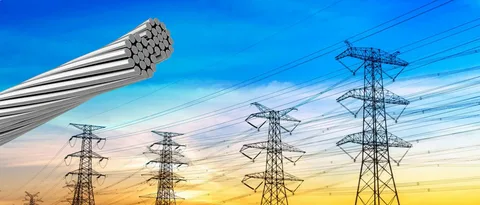Power Transmission Cables: Connecting the World’s Energy Future

Introduction
The global power transmission cables market is undergoing significant transformation as the world shifts toward renewable energy integration, grid modernization, and large-scale infrastructure development. Power transmission cables serve as the backbone of the electricity grid, enabling the efficient transfer of electricity from generation stations to end users. With the growing global electricity demand, the market is witnessing robust growth supported by technological advancements and regulatory initiatives aimed at improving transmission efficiency and reducing line losses. Governments and utilities are focusing on upgrading aging grid infrastructure, driving demand for high-performance cables capable of withstanding harsh environments and long-distance transmission requirements.
Market Drivers
One of the primary drivers of the power transmission cables market is the increasing global demand for electricity. Rapid industrialization, population growth, and urbanization have placed tremendous pressure on existing grid infrastructure. To meet these challenges, countries are investing heavily in transmission and distribution networks, resulting in a surge in demand for efficient and durable cables.
Another major factor contributing to market growth is the expansion of renewable energy projects. The integration of wind, solar, and hydropower into national grids requires advanced high-voltage cables capable of long-distance transmission from remote renewable energy farms to consumption centers. High Voltage Direct Current (HVDC) transmission technology is increasingly being adopted due to its lower power losses and better efficiency over long distances.
Furthermore, government policies emphasizing grid reliability and decarbonization are fueling investments in smart grid technologies. Initiatives promoting energy efficiency, combined with the growing demand for electrification in transportation and industry, are expected to keep demand for transmission cables on an upward trajectory.
Market Challenges
Despite the strong growth potential, the power transmission cables market faces certain challenges. The high initial cost associated with manufacturing and installation of high-voltage cables poses a major barrier, particularly in developing economies. The complex process of installing underground and submarine cables involves specialized materials and labor, increasing overall project costs.
Environmental and regulatory challenges also play a role. Projects involving transmission lines often face delays due to environmental clearances and land acquisition issues. Additionally, the availability of counterfeit or low-quality cables in the market can lead to reliability and safety concerns, potentially undermining consumer confidence.
Another critical issue is the technological challenge of managing power losses and thermal stability in high-capacity cables. Manufacturers are investing in research and development to create better insulation materials and conductors, but these innovations can further increase production costs.
Opportunities
The growing push for renewable energy offers significant opportunities for the power transmission cables market. As offshore wind farms, solar parks, and hydropower projects expand globally, the need for efficient subsea and underground transmission cables is expected to rise dramatically. HVDC cables, in particular, present a key opportunity due to their ability to transfer electricity over thousands of kilometers with minimal losses.
Moreover, the electrification of rural areas and emerging smart city projects in developing nations present lucrative opportunities for expansion. Modernizing transmission infrastructure to accommodate distributed energy resources, electric vehicle charging networks, and decentralized generation will require substantial investments in advanced cable systems.
Technological advancements in cable materials—such as the use of cross-linked polyethylene (XLPE) insulation and superconducting cables—offer potential for improved performance, reduced maintenance, and higher efficiency. This trend will likely open new avenues for manufacturers catering to high-performance applications.
Regional Insights
The Asia-Pacific region dominates the global power transmission cables market, driven by rapid urbanization, growing industrial demand, and massive government-led infrastructure programs in countries such as China, India, and Japan. China’s Belt and Road Initiative and India’s focus on expanding renewable capacity are key contributors to the region’s growth.
In North America, the focus is on upgrading aging grid infrastructure and enhancing grid resilience against extreme weather events. The United States and Canada are investing in transmission projects that integrate renewable energy sources and support the transition to a low-carbon economy.
Europe’s market growth is largely fueled by renewable energy integration and cross-border interconnections to ensure energy security. Offshore wind power developments in the UK, Germany, and Denmark have resulted in significant demand for high-voltage subsea cables.
The Middle East and Africa region is witnessing growth due to industrialization and increasing investments in renewable projects, while Latin America’s market expansion is driven by electrification projects in remote and rural areas.
Future Outlook
The future of the power transmission cables market looks promising, with growing focus on smart grids, digital monitoring, and energy efficiency. Manufacturers are expected to continue innovating in materials and design to enhance performance and reduce environmental impact. The integration of IoT-based condition monitoring systems will enable predictive maintenance, reducing downtime and operational costs.
By 2032, the global market is projected to grow substantially, driven by rising renewable installations and electrification initiatives. As global energy systems transition toward sustainability, high-performance transmission cables will remain indispensable for meeting energy security and climate goals.
Conclusion
The power transmission cables market stands at the forefront of global energy transition efforts. Despite challenges related to cost and environmental constraints, the market’s long-term outlook remains highly positive. Increasing renewable energy integration, government-led grid modernization programs, and technological innovations are expected to drive substantial growth in the coming decade. For manufacturers and investors, this sector presents a pivotal opportunity to support a more connected, efficient, and sustainable energy future.
- Art
- Causes
- Crafts
- Dance
- Drinks
- Film
- Fitness
- Food
- Jeux
- Gardening
- Health
- Domicile
- Literature
- Music
- Networking
- Autre
- Party
- Religion
- Shopping
- Sports
- Theater
- Wellness
